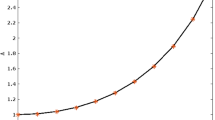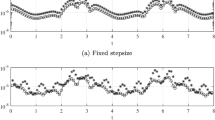Abstract
In this paper we investigate the application of the localized method of fundamental solutions (LMFS) for solving three-dimensional inhomogeneous elliptic boundary value problems. A direct Chebyshev collocation scheme (CCS) is employed for the approximation of the particular solutions of the given inhomogeneous problem. The Gauss–Lobatto collocation points are used in the CCS to ensure the pseudo-spectral convergence of the method. The resulting homogeneous equations are then calculated by using the LMFS. In the framework of the LMFS, the computational domain is divided into a set of overlapping local subdomains where the traditional MFS formulation and the moving least square method are applied. The proposed CCS-LMFS produces sparse and banded stiffness matrix which makes the method possible to perform large-scale simulations on a desktop computer. Numerical examples involving Poisson, Helmholtz as well as modified-Helmholtz equations (with up to 1,000,000 unknowns) are presented to illustrate the efficiency and accuracy of the proposed method.









Similar content being viewed by others
Abbreviations
- \( L \) :
-
Linear differential operator
- \( \Omega \) :
-
Original computational domain
- \( u_{p} \) :
-
Particular solution
- \( u_{h} \) :
-
Homogeneous solution
- \( \overset{\lower0.5em\hbox{$\smash{\scriptscriptstyle\frown}$}}{\Omega } \) :
-
A cubic which contains \( \Omega \)
- \( T_{n} \) :
-
nth Chebyshev polynomial
- N 1, N 2, N 3 :
-
Degrees of Chebyshev’s polynomials
- M :
-
Number of roots of Chebyshev polynomial
- \( \Omega_{s} \) :
-
Local subdomain
- \( N_{s} \) :
-
Number of collocation points inside \( \Omega_{s} \)
- \( M_{s} \) :
-
Number of sources associated with \( \Omega_{s} \)
- \( R_{s} \) :
-
Radius of the local artificial sphere
- \( G \) :
-
Fundamental solution
- \( B(u) \) :
-
Residual function
- \( \xi \) :
-
Root of Chebyshev polynomial
- \( \phi \) :
-
Unknown coefficients in Chebyshev method
- \( \varphi \) :
-
Unknown coefficients in MFS formulation
- \( \omega \) :
-
Weighting function
- m, n, l :
-
Indexes in a sum in Chebyshev method
References
Kołodziej JA, Grabski JK (2018) Many names of the Trefftz method. Eng Anal Bound Elem 96:169–178
Karageorghis A, Lesnic D, Marin L (2018) The method of fundamental solutions for the identification of a scatterer with impedance boundary condition in interior inverse acoustic scattering. Eng Anal Bound Elem 92:218–224
Alves CJS, Antunes PRS (2018) The method of fundamental solutions applied to boundary value problems on the surface of a sphere. Comput Math Appl 75(7):2365–2373
Chen CS, Jiang X, Chen W, Yao G (2015) Fast solution for solving the modified Helmholtz equation with the method of fundamental solutions. Commun Comput Phys 17(3):867–886
Karageorghis A, Poullikkas A, Berger J (2006) Stress intensity factor computation using the method of fundamental solutions. Comput Mech 37(5):445–454
Fairweather G, Karageorghis A (1998) The method of fundamental solutions for elliptic boundary value problems. Adv Comput Math 9(1):69–95
Golberg MA (1995) The method of fundamental solutions for Poisson’s equation. Eng Anal Bound Elem 16(3):205–213
Golberg MA, Chen CS, Bowman H, Power H (1998) Some comments on the use of radial basis functions in the dual reciprocity method. Comput Mech 22(1):61–69
Karageorghis A, Lesnic D, Marin L (2016) The method of fundamental solutions for three-dimensional inverse geometric elasticity problems. Comput Struct 166:51–59
Hon YC, Wei T (2004) A fundamental solution method for inverse heat conduction problem. Eng Anal Bound Elem 28(5):489–495
Chen CS (1995) The method of fundamental solutions for non-linear thermal explosions. Commun Numer Methods Eng 11(8):675–681
Chen W, Fu ZJ, Chen CS (2014) Recent advances in radial basis function collocation methods. Springer, Berlin
Liu QG, Šarler B (2018) Non-singular method of fundamental solutions for elasticity problems in three-dimensions. Eng Anal Bound Elem 96:23–35
Marin L, Karageorghis A, Lesnic D (2016) Regularized MFS solution of inverse boundary value problems in three-dimensional steady-state linear thermoelasticity. Int J Solids Struct 91:127–142
Gu Y, Chen W, Gao H, Zhang C (2016) A meshless singular boundary method for three-dimensional elasticity problems. Int J Numer Methods Eng 107(2):109–126
Wei X, Sun L, Yin S, Chen B (2018) A boundary-only treatment by singular boundary method for two-dimensional inhomogeneous problems. Appl Math Model 62:338–351
Fu Z-J, Xi Q, Chen W, Cheng AHD (2018) A boundary-type meshless solver for transient heat conduction analysis of slender functionally graded materials with exponential variations. Comput Math Appl 76(4):760–773
Cheng AHD (2000) Particular solutions of Laplacian, Helmholtz-type, and polyharmonic operators involving higher order radial basis functions. Eng Anal Bound Elem 24(7–8):531–538
Cheng AHD, Cheng DT (2005) Heritage and early history of the boundary element method. Eng Anal Bound Elem 29(3):268–302
Gu Y, He X, Chen W, Zhang C (2018) Analysis of three-dimensional anisotropic heat conduction problems on thin domains using an advanced boundary element method. Comput Math Appl 75(1):33–44
Marin L, Lesnic D (2002) Regularized boundary element solution for an inverse boundary value problem in linear elasticity. Commun Numer Methods Eng 18(11):817–825
Liu YJ, Mukherjee S, Nishimura N, Schanz M, Ye W, Sutradhar A, Pan E, Dumont NA, Frangi A, Saez A (2012) Recent advances and emerging applications of the boundary element method. Appl Mech Rev 64(3):2–38
Liu YJ, Nishimura N, Yao ZH (2005) A fast multipole accelerated method of fundamental solutions for potential problems. Eng Anal Bound Elem 29(11):1016–1024
Qu W, Chen W, Gu Y (2015) Fast multipole accelerated singular boundary method for the 3D Helmholtz equation in low frequency regime. Comput Math Appl 70(4):679–690
Liu GR, Gu YT (2003) A meshfree method: meshfree weak–strong (MWS) form method, for 2-D solids. Comput Mech 33(1):2–14
Chen C, Young D, Tsai C, Murugesan K (2005) The method of fundamental solutions for inverse 2D Stokes problems. Springer, Berlin. https://doi.org/10.1007/s00466-005-0692-3
Marin L (2010) An alternating iterative MFS algorithm for the Cauchy problem for the modified Helmholtz equation. Comput Mech 45(6):665–677
Fan CM, Huang YK, Chen CS, Kuo SR (2019) Localized method of fundamental solutions for solving two-dimensional Laplace and biharmonic equations. Eng Anal Bound Elem 101:188–197
Gu Y, Fan C-M, Xu R-P (2019) Localized method of fundamental solutions for large-scale modeling of two-dimensional elasticity problems. Appl Math Lett 93:8–14
Gu Y, Fan C-M, Qu W, Wang F (2019) Localized method of fundamental solutions for large-scale modelling of three-dimensional anisotropic heat conduction problems: theory and MATLAB code. Comput Struct. https://doi.org/10.1016/j.compstruc.2019.04.010
Tsai C-C, Chen CS, Hsu T-W (2009) The method of particular solutions for solving axisymmetric polyharmonic and poly-Helmholtz equations. Eng Anal Bound Elem 33(12):1396–1402
Bai Z-Q, Gu Y, Fan C-M (2019) A direct Chebyshev collocation method for the numerical solutions of three-dimensional Helmholtz-type equations. Eng Anal Bound Elem 104:26–33
Reutskiy SY, Chen CS, Tian HY (2008) A boundary meshless method using Chebyshev interpolation and trigonometric basis function for solving heat conduction problems. Int J Numer Methods Eng 74(10):1621–1644
Berger JR, Karageorghis A (1999) The method of fundamental solutions for heat conduction in layered materials. Int J Numer Methods Eng 45(11):1681–1694
Li J, Qin Q, Fu Z (2018) A dual-level method of fundamental solutions for three-dimensional exterior high frequency acoustic problems. Appl Math Model 63:558–576
Lin J, Chen W, Chen CS (2014) A new scheme for the solution of reaction diffusion and wave propagation problems. Appl Math Model 38(23):5651–5664
Chen CS, Karageorghis A, Li Y (2016) On choosing the location of the sources in the MFS. Numer Algoritms 72(1):107–130
Gavete L, Benito JJ, Ureña F (2016) Generalized finite differences for solving 3D elliptic and parabolic equations. Appl Math Model 40(2):955–965
Gu Y, Qu W, Chen W, Song L, Zhang C (2019) The generalized finite difference method for long-time dynamic modeling of three-dimensional coupled thermoelasticity problems. J Comput Phys 384:42–59
Benito JJ, Urena F, Gavete L, Alvarez R (2003) An h-adaptive method in the generalized finite differences. Comput Meth Appl Mech Eng 192(5–6):735–759
Acknowledgements
The work described in this paper was supported by the National Natural Science Foundation of China (Nos. 11872220, 71571108), Projects of International (Regional) Cooperation and Exchanges of NSFC (No. 71611530712), and the Shandong Provincial Natural Science Foundation (Nos. ZR2017JL004, ZR2017BA003, ZR2017MF055).
Author information
Authors and Affiliations
Corresponding author
Additional information
Publisher’s Note
Springer Nature remains neutral with regard to jurisdictional claims in published maps and institutional affiliations.
Appendix A: Source code written in MATLAB_R2018a
Appendix A: Source code written in MATLAB_R2018a









Rights and permissions
About this article
Cite this article
Gu, Y., Fan, CM., Qu, W. et al. Localized method of fundamental solutions for three-dimensional inhomogeneous elliptic problems: theory and MATLAB code. Comput Mech 64, 1567–1588 (2019). https://doi.org/10.1007/s00466-019-01735-x
Received:
Accepted:
Published:
Issue Date:
DOI: https://doi.org/10.1007/s00466-019-01735-x




